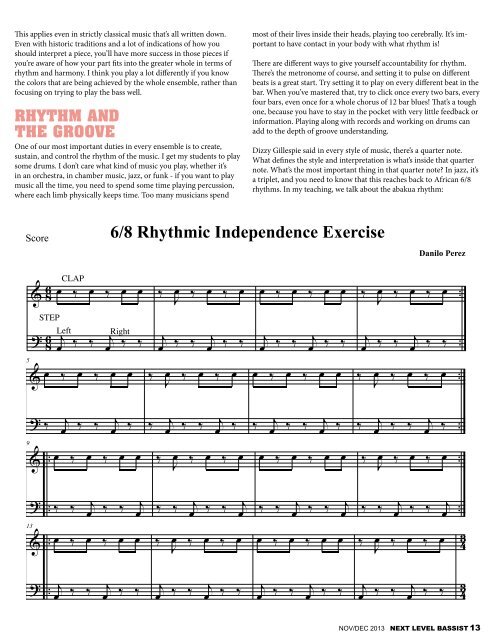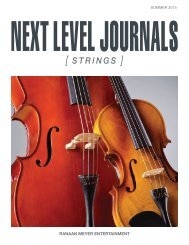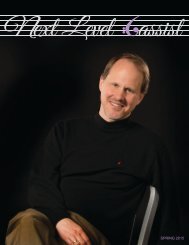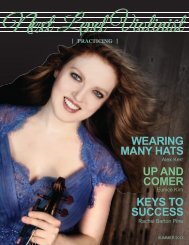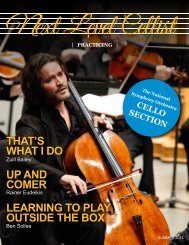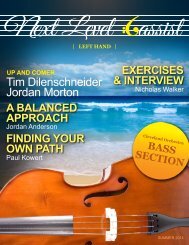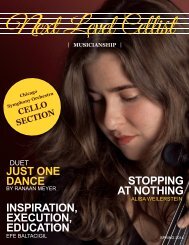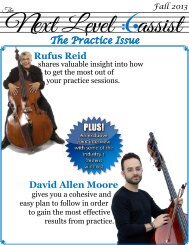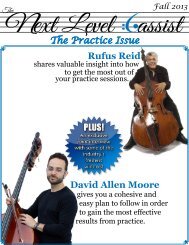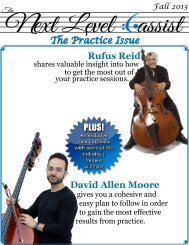Next Level Bassist Musicality Issue
Articles by Sarah Hogan and John Patitucci, Spotlight on the Pittsburgh Symphony, Double Stop Strum by Ranaan Meyer
Articles by Sarah Hogan and John Patitucci, Spotlight on the Pittsburgh Symphony, Double Stop Strum by Ranaan Meyer
You also want an ePaper? Increase the reach of your titles
YUMPU automatically turns print PDFs into web optimized ePapers that Google loves.
This applies even in strictly classical music that’s all written down.<br />
Even with historic traditions and a lot of indications of how you<br />
should interpret a piece, you’ll have more success in those pieces if<br />
you’re aware of how your part fits into the greater whole in terms of<br />
rhythm and harmony. I think you play a lot differently if you know<br />
the colors that are being achieved by the whole ensemble, rather than<br />
focusing on trying to play the bass well.<br />
Rhythm and<br />
the groove<br />
One of our most important duties in every ensemble is to create,<br />
sustain, and control the rhythm of the music. I get my students to play<br />
some drums. I don’t care what kind of music you play, whether it’s<br />
in an orchestra, in chamber music, jazz, or funk - if you want to play<br />
music all the time, you need to spend some time playing percussion,<br />
where each limb physically keeps time. Too many musicians spend<br />
most of their lives inside their heads, playing too cerebrally. It’s important<br />
to have contact in your body with what rhythm is!<br />
There are different ways to give yourself accountability for rhythm.<br />
There’s the metronome of course, and setting it to pulse on different<br />
beats is a great start. Try setting it to play on every different beat in the<br />
bar. When you’ve mastered that, try to click once every two bars, every<br />
four bars, even once for a whole chorus of 12 bar blues! That’s a tough<br />
one, because you have to stay in the pocket with very little feedback or<br />
information. Playing along with records and working on drums can<br />
add to the depth of groove understanding.<br />
Dizzy Gillespie said in every style of music, there’s a quarter note.<br />
What defines the style and interpretation is what’s inside that quarter<br />
note. What’s the most important thing in that quarter note? In jazz, it’s<br />
a triplet, and you need to know that this reaches back to African 6/8<br />
rhythms. In my teaching, we talk about the abakua rhythm:<br />
Score<br />
Score<br />
6/8<br />
6/8<br />
Rhythmic<br />
Rythmic Independance<br />
Independence<br />
Exercise<br />
Exercise<br />
Danilo Perez<br />
Danilo Perez<br />
&<br />
8<br />
6<br />
CLAP<br />
œ ‰ œ ‰ œ œ<br />
‰<br />
œ ‰ œ ‰ œ<br />
J<br />
œ ‰ œ ‰ œ œ<br />
‰<br />
œ ‰ œ ‰ œ<br />
J<br />
.<br />
iano<br />
STEP<br />
Left Right<br />
?<br />
8<br />
6 j<br />
œ ‰ ‰ j œ ‰ ‰<br />
j<br />
œ ‰ ‰ j œ ‰ ‰<br />
j<br />
œ ‰ ‰ j œ ‰ ‰<br />
j<br />
œ ‰ ‰ j œ ‰ ‰<br />
.<br />
5<br />
&<br />
œ ‰ œ ‰ œ œ<br />
‰<br />
J œ ‰ œ ‰ œ<br />
œ ‰ œ ‰ œ œ<br />
‰<br />
J œ ‰ œ ‰ œ<br />
.<br />
9<br />
?<br />
&<br />
?<br />
13<br />
&<br />
‰ j œ ‰ ‰ j œ ‰<br />
. œ ‰ œ ‰ œ œ<br />
.<br />
‰ ‰ j œ ‰ ‰ j<br />
. œ ‰ œ ‰ œ œ<br />
œ<br />
‰<br />
‰ j œ ‰ ‰ j œ ‰<br />
œ ‰ œ ‰ œ<br />
J<br />
‰ ‰ j œ ‰ ‰ j<br />
‰<br />
œ ‰ œ ‰ œ<br />
J<br />
‰ j œ ‰ ‰ j œ ‰<br />
œ ‰ œ ‰ œ œ ‰<br />
œ ‰ ‰ j œ ‰ ‰ j œ<br />
œ ‰ œ ‰ œ œ<br />
‰ j œ ‰ ‰ j œ ‰<br />
‰<br />
J œ ‰ œ ‰ œ<br />
‰ ‰ j œ ‰ ‰ j œ<br />
œ ‰ œ ‰ œ<br />
J<br />
.<br />
.<br />
.<br />
4 3 4 3<br />
?<br />
.<br />
j<br />
œ ‰ ‰ j œ ‰ ‰<br />
j<br />
œ ‰ ‰ j œ ‰ ‰<br />
j<br />
œ ‰ ‰ j œ ‰ ‰<br />
j<br />
œ ‰ ‰ j œ ‰ ‰<br />
NOV/DEC 2013 NEXT LEVEL BASSIST 13


